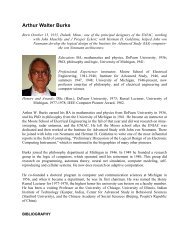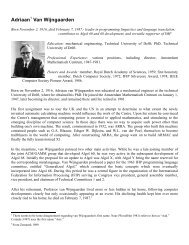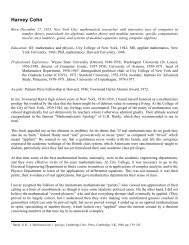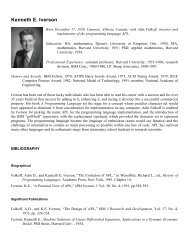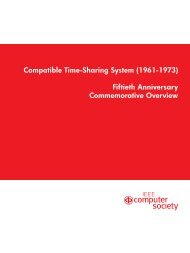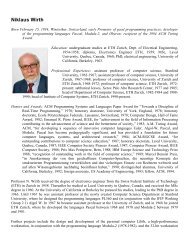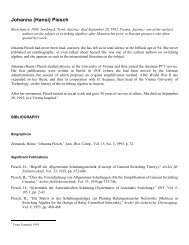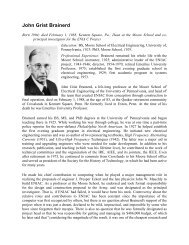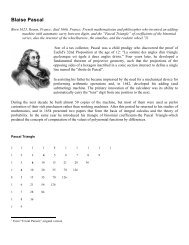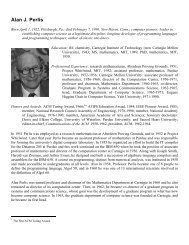Norbert Wiener - Walden-family.com
Norbert Wiener - Walden-family.com
Norbert Wiener - Walden-family.com
Create successful ePaper yourself
Turn your PDF publications into a flip-book with our unique Google optimized e-Paper software.
<strong>Norbert</strong> <strong>Wiener</strong>Born November 26, 1894, Columbus, Miss.; died March 18, 1964, while on tour in Stockholm, Sweden;logician, scholar, and consultant who invented the concept of cybernetics.Education: BA, mathematics, Tufts College, 1909; MA, Harvard University, 1912;PhD, Harvard University, 1913.Professional Experience: docent, Harvard University, 1915-1918; “Computer,”Aberdeen Proving Ground, 1918-1919; MIT: professor, 1919-1960, InstituteProfessor Emeritus, 1960-1964.“I became a scholar partly because it was my father's will but equally because it wasmy internal destiny.” Thus did <strong>Norbert</strong> <strong>Wiener</strong> in his autobiography sum up the forcesthat directed him to be<strong>com</strong>e the mathematical genius whose work achievedinternational reputation. He is noted for his contributions in the <strong>com</strong>municationssciences, in the realm of nonlinear problems in random theory, in the analysis of brain waves, and in theevolution of cybernetics, where he explored the similarities between the human brain and the modern<strong>com</strong>puting machine capable of memory association, choice, and decision making.<strong>Norbert</strong> <strong>Wiener</strong> was born in Columbus, Mississippi, on November 26, 1894. Signs of his genius appeared early.He began to read at age 4, and by 7 his reading ranged from Darwin and Kingsley to the psychiatric writings ofCharot and Janet. He entered Tufts College at age 11 and graduated at 14 with a BA in mathematics andconsiderable study in philosophy. He entered Harvard University and received his MA at age 17 and his PhD at18. With a traveling fellowship from Harvard, he studied in England and Germany under, among others,Bertrand Russell and G.H. Hardy. Upon his return to the US in 1915, he studied philosophy under John Deweyat Columbia University and served as a docent at Harvard.Poor eyesight prevented him from enlisting in World War I, but in 1918 he was accepted into the military andassigned to duty as a “<strong>com</strong>puter” at Aberdeen Proving Ground. He began his career at MIT in 1919. DuringWorld War II, he worked with the Operational Research Laboratory at Columbia on antiaircraft predictors.After 42 years on the faculty he retired in 1960 as Institute Professor Emeritus. Following his retirement, helectured around the world and died on March 18, 1964, while on tour in Stockholm.<strong>Wiener</strong> coined the word cybernetics from the Greek kybernetes (“steersman”) and wrote Cybernetics-Controland Communication in the Animal and the Machine (1948) and The Human Use of Human Beings (1950). Incybernetics he sought to discover the degree to which the human nervous system is a mechanized process as itcarries stimuli to the brain-in other words, how much in a human is unconsciously a machine. The question ledhim to considering automation and how like a human a machine could be<strong>com</strong>e—could a machine assumehuman intellectual capabilities, and when could it exceed and replace a human? In The Human Use of HumanBeings he discussed the desirable features of automation-relief of repetitious drudgery such as assembly-lineproduction, thus freeing people for pursuits that would make greater claim on their creative abilities.
<strong>Wiener</strong>'s awareness of the economic and social dangers stimulated him repeatedly to warn of the necessity forplanned control of automation's progress. 1QUOTATIONS“We are not the stuff that abides, but patterns that perpetuate themselves. A pattern is a message.... We are butwhirlpools in a river of ever flowing water.”“This piece of work is an example of the value and even necessity of <strong>com</strong>bining the machine and the livingorganism, of <strong>com</strong>bining control and <strong>com</strong>munication too, into a unified subject. I've called it cybernetics.”BIBLIOGRAPHYBiographicalBrown, G.S., and <strong>Norbert</strong> <strong>Wiener</strong>, “Automation 1955: A Retrospective,” reprinted in Ann. Hist. Comp., Vol. 6,No. 4, 1984, pp. 372-383.Masani, P., ed., <strong>Norbert</strong> <strong>Wiener</strong>: Collected Works, 4 Vols., MIT Press, Cambridge, Mass., 1976-1986.Masani, Pesi, Brian Randell, David K_ Ferry, and Richard Seeks, “The <strong>Wiener</strong> Memorandum on theMechanical Solution of Partial Differential Equations,” Ann. Hist. Comp., Vol. 9, No. 2, 1987, pp. 183-198.Masani, Pesi, <strong>Norbert</strong> <strong>Wiener</strong> 1894-1964, Birkhduser, Boston, 1992.Tropp, H.S., “<strong>Norbert</strong> <strong>Wiener</strong>,” in Ralston, A., and C.L. Meeks, eds., Encyclopedia of Computer Science,Pertrocelli/ Charter, New York, 1976, pp. 1557-1558.<strong>Wiener</strong>, <strong>Norbert</strong>, I am a Mathematician: The Later Life of a Prodigy, Doubleday, Garden City, NY, 1956. 2Significant Publications<strong>Wiener</strong>, <strong>Norbert</strong>, “Cybernetics: New Field of Study Looks into Processes Common to Nervous Systems andMathematical Machines,” Scientific American, Vol. 1979, Nov. 1948, pp. 14-19.<strong>Wiener</strong>, <strong>Norbert</strong>, Cybernetics, 2nd ed., MIT Press, Cambridge, Mass., 1961. <strong>Wiener</strong>, <strong>Norbert</strong>, God and GolemInc., MIT Press, Cambridge, Mass., 1966. <strong>Wiener</strong>, <strong>Norbert</strong>, The Human Use of Human Beings, AvonBooks, New York, 1969.1Extracted from Brown and <strong>Wiener</strong> 1955.2The cover of this book explains that this is a “continuation of the account of his childhood in Ex-prodigy.”
UPDATESPortrait added (MRW, 2013)






